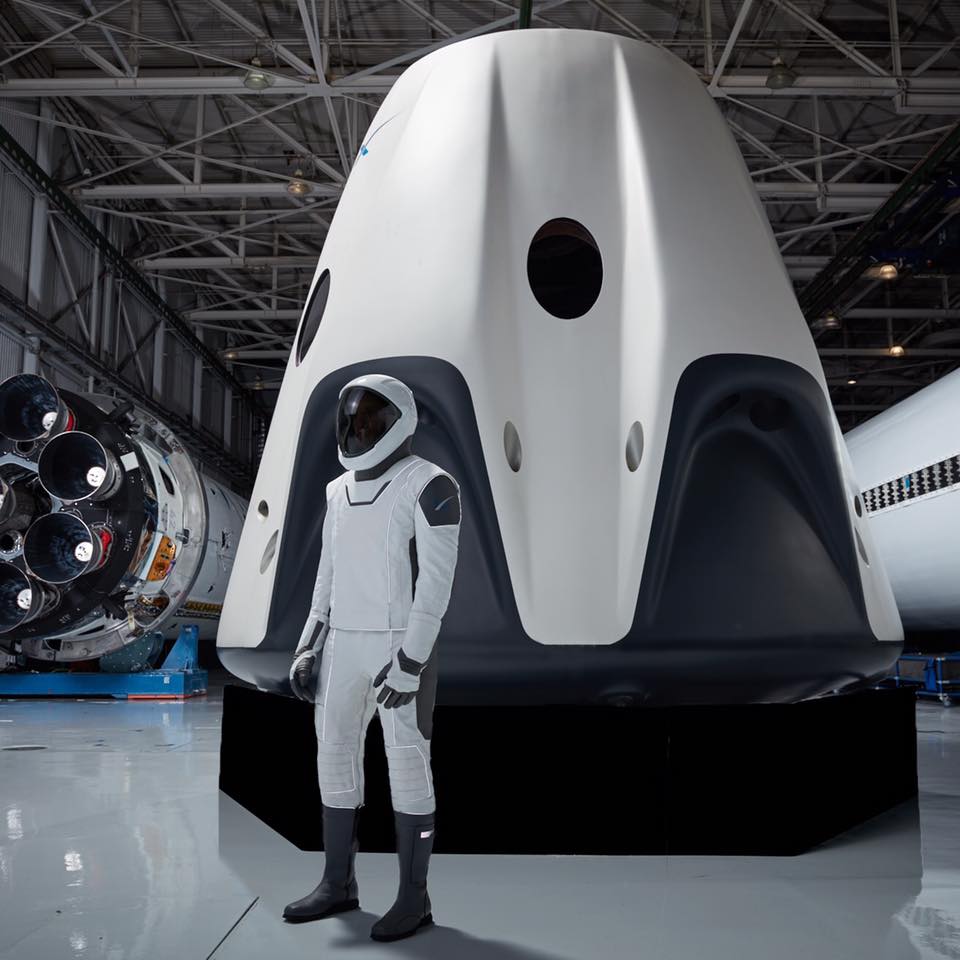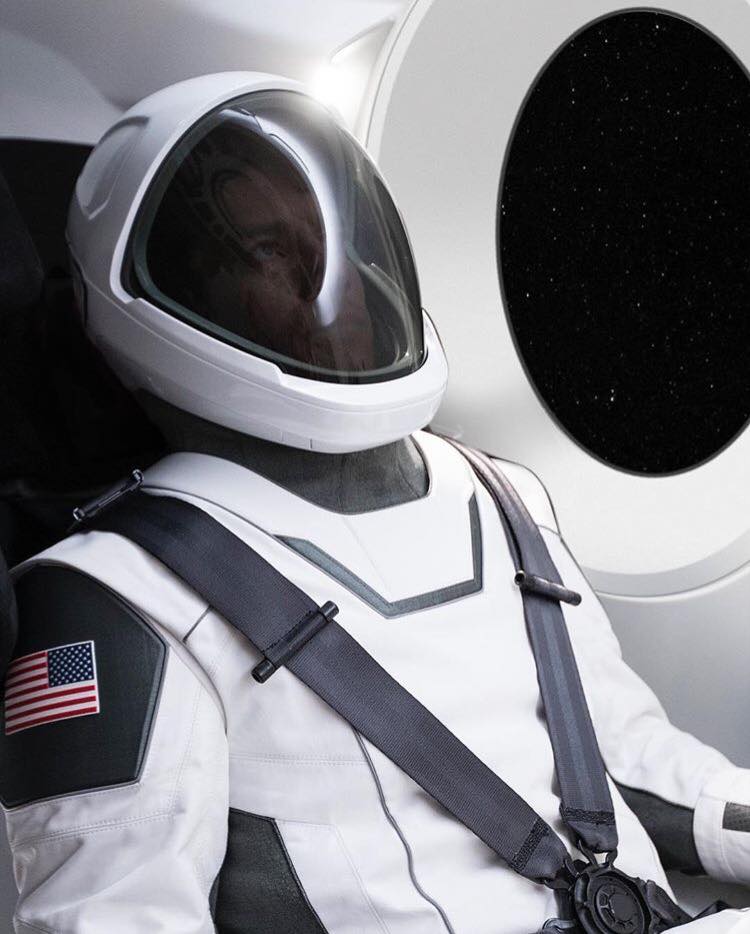SpaceX Has Revealed Its Spacesuits. So When Are We Going To See Them Fly?
September 21, 2017SpaceX is taking on the monumental task of returning humans to the Moon for the first time in 45 years. They plan to do so with a lucrative tourism mission targeted for late next year, and recently, SpaceX revealed the spacesuits that those brave passengers (and future adventurers) will wear.

Photo Credit: SpaceX/Elon Musk
“Our space suits are really cool and they look really good. We’ve spent a ton of time on the engineering–obviously the utility piece. We also wanted them to look really good,” said SpaceX President and COO Gwynne Shotwell. “We’re trying to inspire the next generation, future generations, and maybe even some past generation folks to be thinking about the future and thinking about space travel.”
Among the first passengers to wear those spacesuits will be two private citizens. The unknown pair have paid a “significant” deposit to fly on the Dragon spacecraft and are currently undergoing health and fitness tests to see if they can survive the “long loop around the moon” as CEO Elon Musk describes it. The exact price per seat on the Dragon is still unknown.
The Dragon Crew vehicle will be launched atop SpaceX’s triple-booster Falcon Heavy rocket which Musk touts will be the most powerful launch vehicle in operation when it debuts. So when is that? The Hawthorne, California-based private spaceflight company hopes to launch a test flight of their deep space-capable rocket in just two months from Kennedy Space Center. The Dragon will be tested without crew either later this year or early next.
Humans have not traveled beyond low-Earth orbit since the final Apollo mission in 1972. The International Space Station is about 250 miles above the surface while a trip to the moon could span a distance of 400,000 miles. The far distance will require the 5 million pounds of thrust provided by the triple-booster Falcon Heavy and the safety & comfort provided by the company’s time-tested crew-variant Dragon spacecraft.
“Like the Apollo astronauts before them, these individuals will travel into space carrying the hopes and dreams of all humankind, driven by the universal human spirit of exploration,” said SpaceX in a statement regarding the lunar mission on its website.
SpaceX designed the Crew Dragon to carry a maximum of 7 and “provides a comfortable and safe environment for crew members” with a state-of-the-art Environmental Control and Life Support System (ECLSS). During their trip, crew can toggle the interior climate of the vehicle between 60 and 80 degrees Fahrenheit.
The vehicle is powered by eight SpaceX-built SuperDraco engines which will help enable the Dragon’s launch abort system that can safely jettison the crew capsule in the case of an anomaly during liftoff. SpaceX claims the G-force experienced by crew during an emergency abort will be similar to a ride at Disneyland.
Crew Dragon can be piloted by a crew member or by mission control at SpaceX’s headquarters in Hawthorne, California.
The Dragon 2 vehicle is essentially an upgraded variant of the current cargo-carrying Dragon that has been flying since 2010 when it helped SpaceX became the first commercial company to recover its own spacecraft from orbit. Two years later, the Dragon became the first commercially-built spacecraft to rendezvous and successfully dock with the space station.
The Crew Dragon vehicle will be reusable and SpaceX hopes to fly it a few times to the International Space Station before it needs it needs to be heavily refurbished. Moon flights will be far more grueling on the Dragon and will probably be refurbished after a single flight.
SpaceX will launch its lunar tourists from the historic Launch Complex 39A at NASA’s Kennedy Space Center in Florida. Pad 39A once hosted the historic launches of the Apollo program that put men on the Moon and the celebrated space shuttle missions that helped build the Hubble space telescope and the ISS.
SpaceX has signed a 20-year lease with NASA to host launches at LC-39A and about 15 years after SpaceX launches its first crewed mission to the space station and the first pair of tourists, Elon Musk envisions another historic crew launch taking place at the site: the first human mission to Mars.
“We’re in the process of building a number of Dragon 2 spacecraft and we are targeting to launch that first demonstration flight later this year. From this pad actually,” said Gwynne Shotwell during a press conference at Launch Complex 39A earlier this year. “There’s still more work to do on the pad to get it prepared for crew. We’ve got a crew arm to put in and we’ve got some other upgrades as well that we’ll work on in between the launches we execute here from 39A.”
NASA has awarded SpaceX over $3.1 Billion in commercial contracts to develop a human spaceflight using Dragon and fly four missions a year to rotate the crews and send supplies to the International Space Station. Following SpaceX’s moonshot announcement, NASA put out a statement “commending its industry partners for reaching higher.”
Spacex’s first crewed mission to the ISS is expected to occur in late 2018 with the transport of two NASA astronauts to the laboratory for a 14-day trip. If SpaceX can accomplish this feat within this timeline, they could be responsible for returning human spaceflight to American soil for the first time in 7 years. Boeing has also been awarded a commercial crew contract by NASA to fly their Starliner vehicle with passengers to the space station beginning around the same time.
NASA currently pays close to $80 million a seat to the Russians for a lift aboard their Soyuz spacecraft. If SpaceX flies a full crew aboard the Dragon 2, they can reduce the price per passenger to around $20 million a person. Elon Musk claims that trips around the moon would only cost “a little bit more” than flights to the space station.
When questioned about possible delays facing the first crewed flight of the Dragon 2 citing possible safety issues, SpaceX’s president responded with a “the hell we won’t” and insisted they will fly crew in 2018.
With SpaceX beginning human spaceflight in 2018, the company’s long-term plans to build a city on Mars and push out through the solar system is coming into focus. “We’ve not been shy about saying that really the reason why SpaceX was founded or why Elon founded this company was to build space transportation systems that could ultimately take people to other planets. We’ve got our sight on Mars,” explained Shotwell.
Featured Image Credit: SpaceX/Elon Musk









